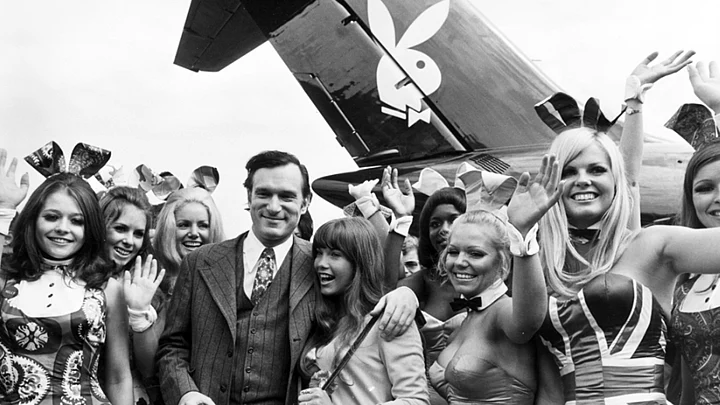I am sure I’m not just speaking for myself. In fact, for many of us post-Midnight Children, born when the nation was evolving its independent identity, Playboy magazine founded in Chicago, 1953, swiftly became our Guilty Pleasure No 1.
Growing up amidst corseted families, no kind of Lipstick under Veils then - exacerbated by persisting Anglo-Saxon school strictures - Hugh Hefner’s publication was strictly taboo. Which meant that the forbidden fruit, if I may call it that, became the centrefold to go to. Under the cover of the night, the nude spreads of young women, lit by amber soft light, sparked endless dreams. For many, that was the first step towards self-learnt sex education.
Also Read: Porn Mag Magnate Hugh Hefner Passes Away in Playboy Mansion at 91
Playboy was banned in India, of course. Oddly though, come the 1960s, every new issue was freely accessible at the now-defunct circulating libraries (in my case, Shemaroo at Warden Road). The father of a school friend, Kookie Moloobhoy, showily dressed up in silk pajamas and gold-thread-embroidered bathrobes, in a style patented by Hefner, would send us out on an errand. “Get ‘something’ which has been kept wrapped for me from Shemaroo… and don’t you boys dare to sneak a peek.”
Naturally, that rule would be broken. Right away we’d peek at the centrefold – featuring the nude Playmate of the month. As time elapsed, never mind if we hadn’t even sprouted wispy moustaches – Kookie and I’d rent the magazine ourselves. “Return within 24 hours,” would be the Shemaroo ledger keeper’s diktat.
A whole, new glossy world opened up for us acned-school kids. Till then, we’d learnt about the… err... birds-and-bees from the smutty, graphically descriptive sex-‘n’-lust porn stories from the olive-coloured Olympia press paperbacks, euphemistically described as ‘travelling companions’ – or ‘essentials’ to be carried on long-haul train-and-car journeys by American salesmen.
Today, the obituaries about Hefner acknowledge him as the pioneer of the sexual revolution, an exotic host to celebrities at his palatial homes. Or should that be harems? Celebrating sexual and aspirational instincts, Playboy – starring the Bunnies wearing a bow tie, a skin-tight outfit accentuating the cleavage and a furry powder puff stitched to the derriere – catered unashamedly to the male fantasy.
In retrospect, it could be argued that the gambit reeks of shameless sexism.
That’s a more-than-valid point of view surely. Others, myself included, could argue back, “Come on, let’s not be puritanical. Compared to today’s internet porn, the Playboy Playmates are about as corruptible as a teddy bear’s picnic.” Tricky viewpoints both.
To this I’d add that the magazine’s permissiveness was a corrective to the Bollywood movies of yore. These would suggest that babies were produced when two bicycles crashed into each other (see Yash Chopra’s Dhool ka Phool) or when two bright hued daisies necked in close-up on screen. Moreover, who was to talk to us about sex? Certainly not our school teachers or the elders at home? Hefner, in a subliminal way, served as our sex educator. Honest!
Playboy magazines could be picked up through the last millennium at international airports’ duty-free shops. Customs officers would turn a blind eye towards them mostly, training their sights instead on undeclared electronic goods, gold bars, you know the drift. Concurrently, The Hustler, Penthouse and Maxim (the only publication which outsold Playboy) became the preferred options for those who wanted the content to be raunchier.
As our moustaches and beards thickened, Playboy became tamer, not quite in sync with the sexgeist of the 21st century. We 20th century wallas had moved on, those bold and beautiful centrefolds seemed like a chhota peg of Jack Daniels spiked with a bucketful of water.
Meanwhile Debonair, India’s version of Playboy – which was at its prime during the editorship of the late Vinod Mehta – went pffft.
Incidentally, the poseurs among us – myself included – would often huff, “Hey, Playboy was much more than a girlie magazine. It carries great interviews with the likes of Jean-Paul Sartre, Bertrand Russel, Marlon Brando, Malcolm X, American Presidents. And it has short stories by Vladimir Nabokov, James Baldwin, John Updike, Kurt Vonnegut, oh so many.”
Frankly though, the Playboy centrefold was its USP. The element of gravitas was an add-on.
In my minor way, I attempted to incorporate a scene depicting the influence of Playboy in my first film screenplay: Mammo directed by Shyam Benegal. I can’t say whether that scene appealed to all but I do know that it did to many, drawing bemused laughter at film festival screenings.
Now, there’s no need for reading (ha!) Playboy under the cover of the night. Hefner’s gone. And so have those days when rules were meant be broken, my friends.
(At The Quint, we question everything. Play an active role in shaping our journalism by becoming a member today.)
